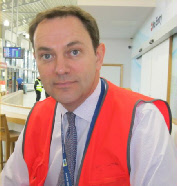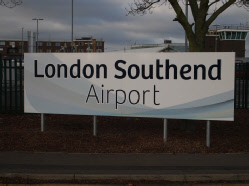

Make a point of visiting us weekly! Tell a friend about us.
London Southend Airport
4. Talking to the Managing Director
4. Talking to the Managing Director
Main airport web-site link: http://www.southendairport.com
Return to front Airport Introduction page
Return to front Airport Introduction page


Talking with Alastair Welch, Managing Director of London Southend Airport
(21st May 2013)
(21st May 2013)
Alastair Welch is Managing Director of London Southend Airport and we asked for an interview with him to catch a sense of the role of MD in this airport on our doorstep. What does it involve? We have somewhat curtailed the length of the article to more specifically catch the ‘big picture’ of Alastair’s role. (See end comment).
Rochford Life: Alastair, I know this a somewhat mundane question, but what actually does the Managing Director of an airport do?
Alastair: I think it varies from airport to airport but in Southend my prime role is to make sure that aircraft operation and passenger operation are safe and secure. I am the licence holder of the aerodrome so that means I am accountable under the Aviation Act for a number of things relating to the safety of aircraft, to fire services at the airport, the air traffic control at the airport and so on. While the fire fighters and air traffic controllers are individually licensed I have to make sure that we comply with the rules and regulations that apply to what we are doing. In addition, from the point of view of security, we obviously have obligations under the law for passenger security, as well as other matters, so there is a very strong legal compliance side to my role. I also need to make sure that the airfield is safe to operate and while I delegate to staff to look after that, it is my responsibility.
RL: So, as you say, very much a legal compliance role?
Alastair: Yes, but beyond that, Southend Airport is a business; we have several hundred staff who work here, we have thousands of staff who rely on the airport directly and we need to make sure that the forty or so tenants that we have here at the airport, operate the way they should be doing and their leases are appropriate and so when they are renewed they are renewed appropriately. Also as well as managing the property side of things, we also have the railway station that we look after, the hotel that we own and look after. We have to make sure that the income is where it needs to be, and the service levels are where they need to be and ultimately we are trying to generate a profit for our shareholders who have invested about a £100M in the airport. I also look after an airport in Carlisle. My wider responsibility is as the managing director of Stobart Air, which is the air division of our parent company, and so there is an airport in Carlisle I am responsible for as well. We have an airport director in Carlisle who looks after day to day running and he is the license holder in Carlisle, but I am also accountable for the performance of the aerodrome there.
RL: When you say you are ‘responsible for’ does that mean that you have to make sure that the rest of your staff do all this?
Alastair: No, that’s a nice idea but I think the reality is that if, supposing, I was at Heathrow, I would have an army of people who do things for me, but with an aerodrome the size of Southend there aren’t armies of people out there and so, for example, I will be personally involved with the specification of all the developments that we are building now, and I will be involved with matters pertaining to all correspondence that comes to the airport, negotiating individual contracts, individual tenancies, individual perimeters and that sort of thing, so you have to get involved with a huge amount of detail. We obviously do have a team in place but we haven’t got hundreds of people out there in terms of, say, our community team or our external affairs team or our public affairs team.
RL: What qualifications does someone have to have to do this job?
Alastair: Well, the Civil Aviation Authority need tp deem you competent before they will allow you to be the named license holder and there are various things you can do to assure that, but essentially that is often by experience and activity elsewhere. You also have to go through various clearances before you can accept responsibility in law, but from my point of view, my degree is in mechanical engineering and I then did accountancy after that. I worked for BAA at Heathrow and had various roles in BAA over about eleven years, in terminal operations, corporate strategy, corporate finance and other operation and general managerial roles, and then I came here. I have been at Southend since February 2007, so a little over six years.
RL: You sound like you enjoy it. Does the fact that it is developing all the time give a sense of fulfilment, being part of that?
Alastair: If you think of the redevelopment of Southend as a project, with any project you do your ground work and you understand what you are trying to achieve, and in our case we lined up various consents from a regulatory point of view, and from a planning point of view, and over a period of time we secured the funding we needed, and the plan is coming together, so it is always good when a project you are planning for many years comes to the point when you feel it is being delivered.
RL: Is the airport going to be limited by how much it can grow by the fact that is it surrounded by built up areas?
Alastair: Well I think there are two different limitations. One is that there is a planning cap, a legal cap on the number of movements that are allowed. There wasn’t in the past but there is now, and that came in place as part of the runway planning consent. The airport in the 1980’s was handling about 110,000 flights a year, and we now have a legally binding cap that limits us to about half that, 53,000. So we have a cap that we cannot exceed of 53,000 movements a year and that is, if you like, an artificial restraint which is less than we used to do but that is part and parcel of the consent we had to redevelop the airport. That is the actual cap. Secondly, can the airport handle more movements? Well it did in the past so technically it could but that would require a massive planning application for consideration in due course, one day in the distant future.
RL: I presume reasons were given for the cap?
Alastair: What we did as part of the runway planning application was assess the impact of development and so on, and part of that was to think, what are you trying to develop in terms of facilities, capacity and so on and how many movements would you have to have to deliver that, and then you consider the impact those movements would have, so the environmental impact is properly assessed. We believe that at around two million passengers, our forecast of fifty odd thousand movements a year is met and the effect of those fifty odd thousand movements were what we assessed, so that is the package that came together in the planning application.
RL: Will there be a possibility in 2020 for reassessment?
Alastair: We planned numbers and movements of about two million passengers by about 2020. Now if there was either a desire or a case to further that number, that would be an argument to have nearer the time. The Government has a commission for looking at airport capacity in the South East and the Davies Commission had a recent call for evidence to ask how would we like to make best use of existing capacity or existing runway capacity. It is only right that we, as part of our submission, should say, well, technically, yes we could handle more but that is not a matter that we could even contemplate at the moment, and is more a matter for planners in the future, if that was the requirement.
RL: I note that on BBC Southeast the other evening, Cambridge are trying to grow their airport. Is there a competitive thing about competing for what must be a limited demand in the industry?
Alastair: It’s a very interesting industry and is changing very quickly. People are travelling more and more whether it is for new business or whether to see friends and relatives or for a holiday. People are travelling more and they are travelling more by air. So the amount of traffic required to meet these demands is increasing and what we are seeing, I think, is a change of people who go to airports, often now for long-
RL: From how you respond to that, it seems part of your remit is to watch the big picture as well as manage the local facility?
Alastair: I think it is more straight forward in that, as with any business, you have to watch what the opposition is doing, but we work in an environment where we not only have to comply with a terrific number of regulations, we have to inform the structure of those regulations so those regulations may be set in Europe by the EU, or by ICEO in Chicago or they may be set in the UK. Thus we have to work with European Ministers and Commissioners and I will meet with them to discuss relevant matters, and in the UK we meet with Ministers and officers to make sure that the rules are right for the UK and again, with ICEO, the overarching organisation. At the moment we are currently working to reinstate controlled airspace, the air above us, to further improve the way we manage aircraft operations and that is something that involves consultations with people right across Essex and in Kent and also has a strong interaction with Government and so on. It’s a process that takes about two and a half years and so there is a huge amount externally to do as well as running the day to day.
RL: One thing one can’t help but notice when you come here is that the Terminal extension is far on. Is it on time?
Alastair: There are four phases to the Terminal extension. The first phase is that we open a new Arrivals facility which is at the far end of the Terminal by the Control Tower, and that will open during June. Once that is open we can progress work to a new enlarged security area and that is the second phase to be ready in October and opened early in November. The third phase is the current Check-
RL: Well Alastair, thank you very much for your time and for sharing in such detail. Thank you
(We should also note that in our conversation with Alastair we ranged over such detailed subjects as airport parking, security, and local concerns, and on all subjects Alastair gave us comprehensive and detailed information in response to our questions. We have omitted those parts of the conversation as we have concluded they detract from that the overall ‘big-
Top of page